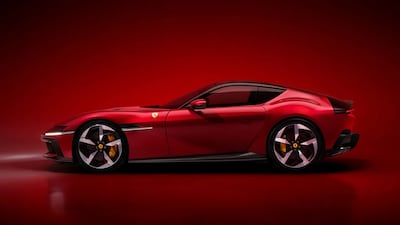Ferrari is digging into its archives to stay ahead of the competition.
The Italian manufacturer unveiled its latest combustion engine sports car on Thursday in Miami, inspired by its touring models from the 1960s.
Priced at $423,000, the two-seater 12Cilindri – Ferrari prefers you call it Dodici Cilindri – will come in both closed-roof and convertible versions. And as the name suggests, it features a 12-cylinder engine packing a whopping 819hp. With a top speed of more than 340kph, the car can race to 100kph in 2.9 seconds.
Weighing 1,560kg, the 12Cilindri is styled like a berlinetta, or little saloon in Italian, with a glass roof that swoops low in the back. A novel design in front replaces traditional headlights with a single wraparound band reminiscent of the Ferrari Daytona.
Inside, the traditional Ferrari steering wheel is adorned with controls, accompanied by a central infotainment display. Overall, it is not too different from the Purosangue, which Ferrari unwrapped in 2022 to enter the lucrative market for sport utility vehicles.

“The car is the perfect explanation of Ferrari – tradition and innovation,” said Enrico Galliera, the company's chief marketing and commercial officer, at the event.
“We were inspired by the gran turismo cars of the 1950s and 1960s. It was important to have a certain level of comfort because the races were six, 12, 24 hours.”
Deliveries of the closed-roof 12Cilindri version will start by the end of the year, with the convertible arriving early next year.
Ferrari’s reputation for quality have helped make it the strongest luxury automotive brand in the world, according to Bloomberg Intelligence. It recently outpaced its peers for a second consecutive year.
“We suspect this trend will continue as none of the concerns about the broader auto industry – rising prices, increasing subprime auto loan delinquencies and the potential for write-offs of electrical vehicle investments – should vex the Italian sports car manufacturer,” said Joel Levington, director of credit research for Bloomberg Intelligence.
Agencies contributed to this report










